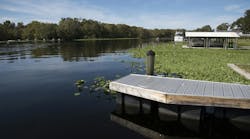New York requires USACE to overhaul flooding plan for NY-NJ harbor
New York State has required the U.S. Army Corps of Engineers to better protect communities and the region from frequent flooding harms, according to a press release from the Environmental Defense Fund (EDF).
In response to demands from the public as well as state and federal elected officials, the New York State Department of Environmental Conservation (NYSDEC) last week sent a letter to overhaul a $52.6 billion storm surge protection plan proposed by the U.S. Army Corps of Engineers (Corps).
The State’s letter triggers a required process in federal law for the Corps to holistically study and provide solutions to address frequent tidal and river flooding, heavy rainfall, groundwater emergence, erosion, sea level rise, and storm surge as a part of the Corps’ New York- New Jersey Harbor and Tributaries Study.
“We applaud New York State in calling for a comprehensive approach to flooding — one that prioritizes sound science and engagement with at-risk communities,” said Kate Boicourt, director for EDF’s Climate Resilient Coasts and Watersheds New York-New Jersey program. “By requesting changes to this project, we can minimize inequities and costly damage, as well as help communities build the future they deserve.”
The state’s letter joins concerns raised by a group of 14 bipartisan Members of Congress and 38 New York State legislators.
Specifically, the Corps must:
- Undertake a “multi-hazard” assessment of the projects in the study, considering all sources of flooding — from heavy rainfall to groundwater inundation to sea level rise — consistent with the requirements of the Water Resources Development Act of 2022;
- Issue a Supplemental Draft Environmental Impact Statement, for public review and comment, that includes the new analyzes and new or modified alternatives; and
- Finalize a plan only after completing the above.
NYSDEC also directed the Corps to:
- Adopt a phased, adaptive management approach, allowing for project modifications based on environmental assessments and community and stakeholder feedback
- Move individual project elements forward as they are ready, not trying to move the entire suite as one project
- Hire an external firm to lead outreach and engagement with environmental justice communities, and engage in regular, substantive public discussions
This step prevents taxpayers from spending $52.6 billion on the country’s most expensive coastal infrastructure plan and have it only protect the region from one kind of flooding — storm surge.
More than 50 organizations in New York and New Jersey have been campaigning for these critical changes to the New York-New Jersey Harbor and Tributaries Study plan, stating that the Corps needs to study solutions that reduce risk and vulnerability from all kinds of flooding, prioritize protections for environmental justice communities, and incorporate nature-based and nonstructural features whenever possible.
“As a critical partner in the development of a comprehensive resilience plan for the New York and New Jersey Harbor region, New York State has made it clear the Army Corps' New York-New Jersey Harbor and Tributaries Study (HATS) must adopt a multi-climate hazard lens,” said Cortney Koenig Worral, president and CEO of the Waterfront Alliance. “A project of this caliber must incorporate solutions that protect our residents, infrastructure, and natural ecosystems from risks beyond just storm surge. Waterfront Alliance and the Rise to Resilience Coalition have long called for meaningful community empowerment and a more adaptive, iterative approach to this study.”


